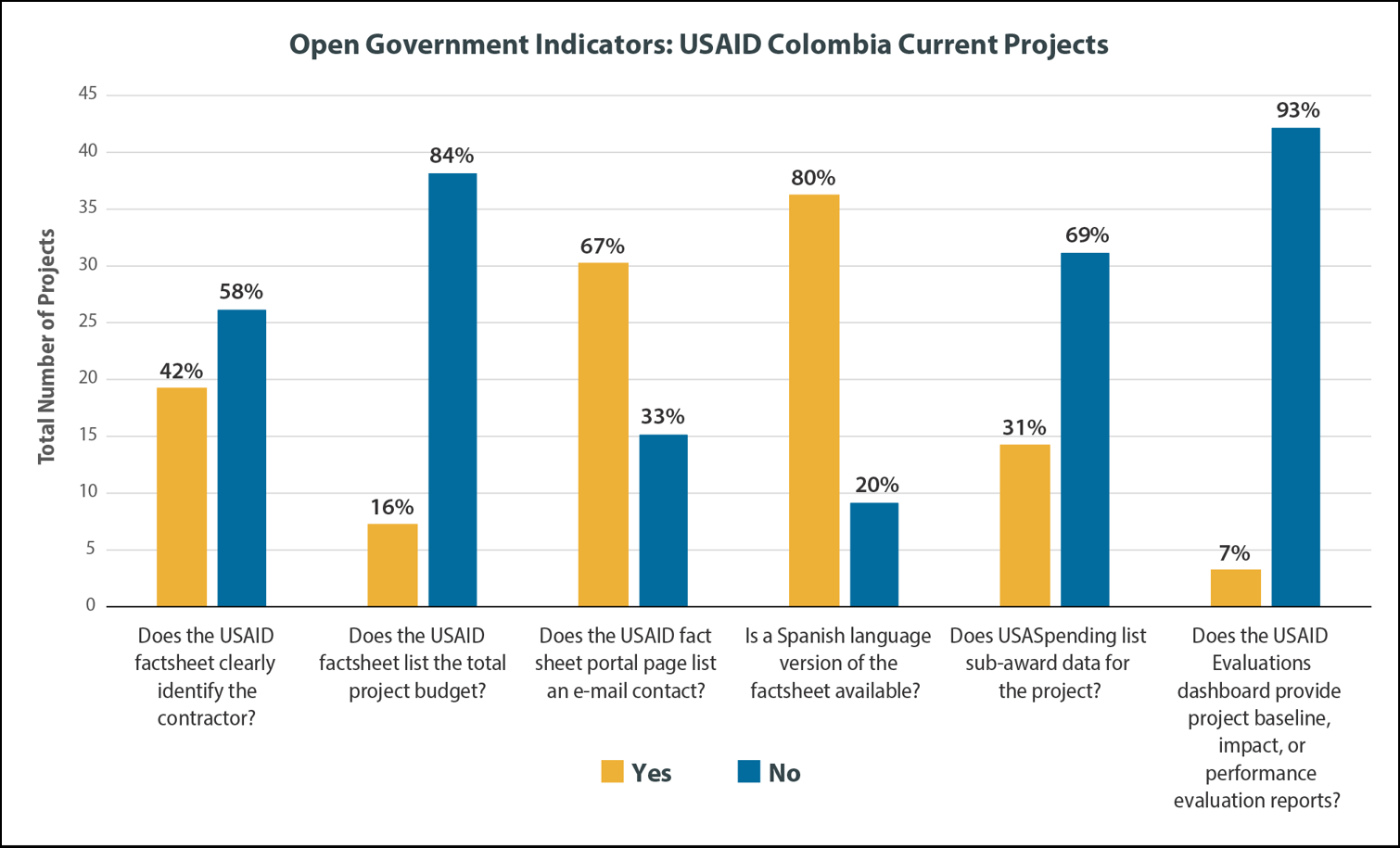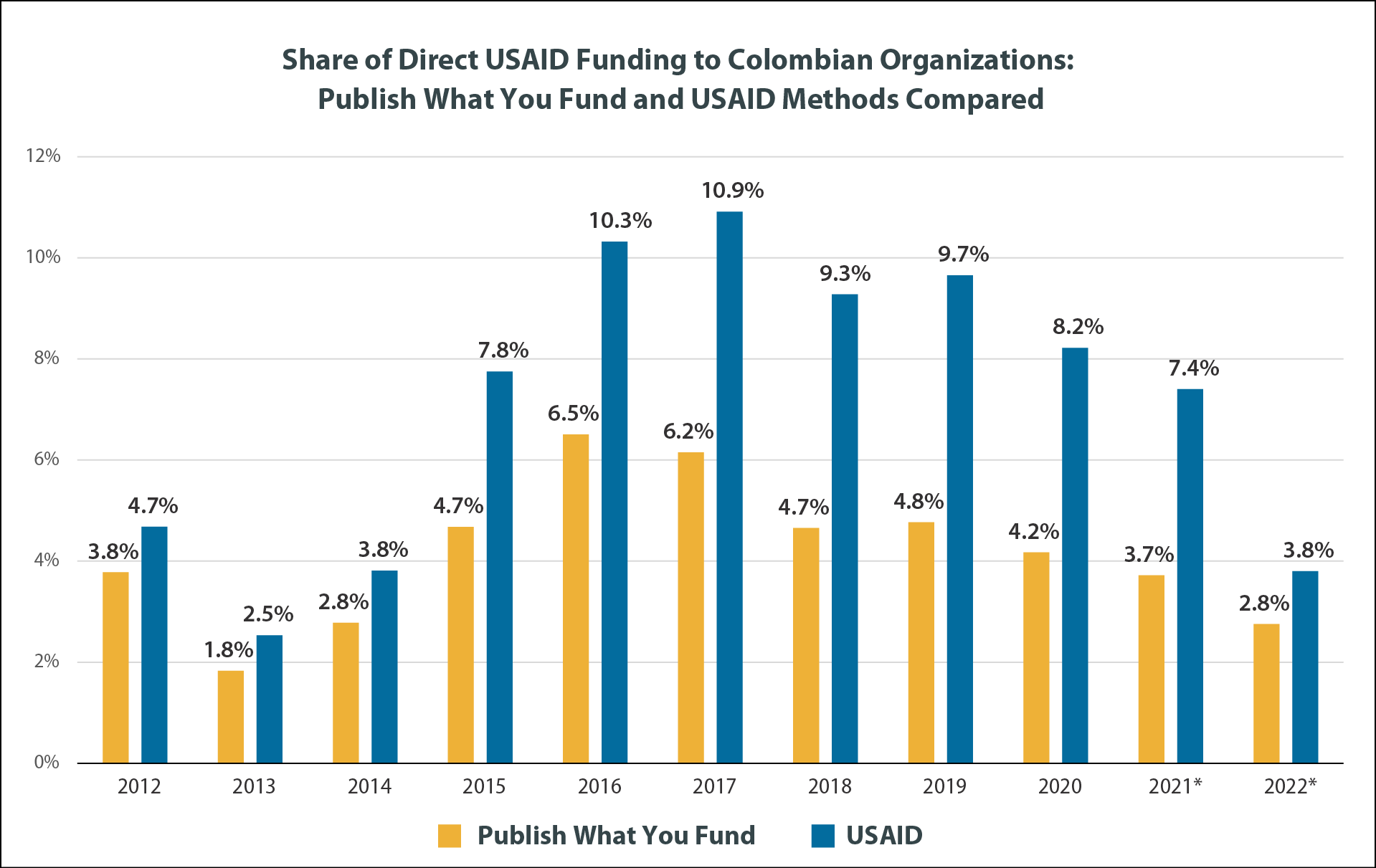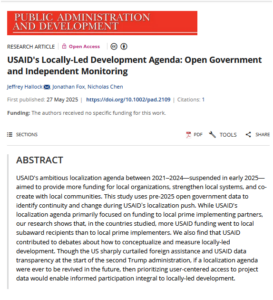User-centered access to information about what donors are funding is necessary to understand whether development aid is becoming more ‘locally-led’. Connecting the dots across fragmented official data sources, this project assessed USAID’s information disclosure practices, traced its sectoral priorities, and identified patterns of funding to 'local' organizations.
Image credit: Jeffrey Hallock
Since January 2025, the future of U.S. development assistance has become unclear. We welcome suggestions on the continued relevance of this line of work, and suggestions for what direction to take it in.
Open Government Matters for ‘Locally-Led’ Development
In 2021, the U.S. Agency for International Development (USAID) pledged to significantly increase the proportion of development assistance it provided directly to organizations based in aid-recipient countries, aiming for 25% by 2025. It also pledged to include ‘locally-led’ input on project design, agenda setting, and evaluations in 50% of its program spending by 2030.
Analyzing the progress USAID made towards these goals requires public disclosure of accessible, relevant information about funding and activities, both within and across projects. Only disaggregated budget data reveal project priorities in practice.
User-centered public access to information about the flow of development aid can enable stakeholders to follow the money, spotlight progress, identify bottlenecks, as well as to provide informed input into broader development aid agendas.
This project applied open government analysis to the ‘locally-led’ agenda through: an in-depth analysis of USAID’s Colombia portfolio; how-to guides to inform public access to subaward spending data and evaluations; a global overview of access to information about projects on land and indigenous peoples; a new tool for tracking country and project level localization trends; and eight brief country portfolio overviews.
To access the datasets on which much of the analysis on this page is based, go to the American University Research Archive.
This Public Administration and Development article by Jeffrey Hallock, Jonathan Fox, and Nicholas Chen uses pre-2025 open government data to identify continuity and change during USAID’s localization push.
Focus Areas
1. Public Access to Project Data: Colombia Spotlight
USAID made very gradual progress towards more direct ‘local’ funding as a share of its global portfolio. But in some countries, including Colombia, the local share fell rather than rising.
This open government analysis assessed public data about U.S. government funding trends in Colombia. It reviewed sectoral funding trends and which organizations were receiving project funding. Taking a user-centered approach to open government, it also focused on information accessibility and legibility.
- USAID’s Locally-Led Development Agenda: Open Government and Independent Monitoring (Public Administration and Development article, May 2025)
- Gobierno abierto y cooperación estadounidense al desarrollo en Colombia: lecciones para entender la localización (book chapter, May 2025)
- Open government and U.S. development cooperation in Colombia: Lessons for understanding locally led development (Development Policy Review article, July 2024)
- How More Open Government Can Bolster USAID’s Localization Agenda (blog, September 2023)
- Hallazgos principales: Análisis de gobierno abierto en el financiamiento de USAID a Colombia (Memo)
Data and technical analysis

Sources: USAID Colombia (accessed August 2023); ForeignAssistance.gov (accessed August 2023); Evaluations at USAID Dashboard (accessed August 2023).
2. Public Access to USAID Contractor Subaward Data
When available, USAID subaward data provided important information about subcontractors that are relevant for tracking ‘locally-led’ development. Official subaward data were difficult to locate, not linked on USAID project sites, not always published per reporting requirements, contained significant errors, and may be redacted without public disclosure or justification.
This analysis of USAID subawards includes a review of data errors and a step-by-step guide on how to access and download subaward funding data.
- USAID Subaward Data: Barriers to Public Access and Widespread Errors (PowerPoint)
- How to Access USAID Subaward Data: Step-by-Step Guide to Navigating USASpending.gov (PowerPoint)
3. Public Access to USAID Project Implementation Reports and Evaluations
USAID project implementation reports and evaluations were not linked to USAID project websites. Instead, they were available from two main sources: the USAID Development Experience Clearinghouse (DEC) and the Evaluations at USAID Dashboard. DEC was difficult to use but also included project implementation reports, while the evaluations dashboard was more user-friendly but covered a limited period (2016-2022).
This analysis focuses on accessing USAID’s instructive implementation reports and evaluations on the DEC.
4. Public Access to USAID Portfolio Trends: Land Tenure and Indigenous Rights
ARC conducted a pilot overview of USAID’s global funding trends for specific topic areas, starting with land tenure and indigenous rights.
Land tenure and indigenous rights were priority issues for USAID. Yet the full scope of projects under these portfolios was difficult to assess as USAID did not publicly tag all related projects under these two issue areas.
- Analysis of USAID Colombia Ethnic Inclusion Projects (PowerPoint)
- Preliminary Review of USAID Indigenous and Land-Related Projects (Memo)
- USAID Carbon Offsets and Sequestration (PowerPoint)
5. Localization Search Tool: USAID ‘Local’ Funding Trends FY2020-2022
The ARC USAID Localization Dashboard enables interactive visualization and analysis of USAID’s self-reported direct funding figures by collating data from USAID’s FY 2022 Localization Report and USAID’s dataset for Direct A&A Funding for Localization (Excel file). The dashboard enables fine-grained examination of data not made easily available by USAID and provides:
- downloadable and searchable data tables detailing USAID project data by country
- visualizations of USAID’s self-reported direct local funding percentages from the FY2022 Localization Report
- visualizations of USAID funding obligations based on USAID designations of contractors as ‘local’ or ‘non-local’, with an option for country-to-country comparison.
Click below to access the Dashboard

Source: International Aid Transparency Initiative (Country Development Finance Data – Colombia, accessed May 31, 2023). USAID figures for 2021 and 2022 are from USAID’s report “Moving Toward a Model of Locally Led Development”. See also, Tilley and Jenkins (2023) “Metrics Matter: How USAID Counts “Local” Will Have a Big Impact on Funding for Local Partners,” Publish What You Fund.
An asterisk denotes that public data is reported as not complete for the year when accessed.
Publish What You Fund and USAID define ‘local’ organizations differently. For Publish What You Fund, local denotes the recipient organization’s primary headquarters is in the recipient country; for USAID, it includes nationally incorporated branches of international entities.
6. Sectoral and Direct Local Funding Trends: USAID Country Profiles
These preliminary country profiles briefly analyze development project priorities, sectoral trends in U.S. foreign assistance, and changes in direct local funding (2021-2022).
They used data from USAID mission pages, USAID reports, ForeignAssistance.gov, USASpending.gov, and the International Aid Transparency Initiative (IATI).
-
- Bangladesh (PowerPoint)
- Guatemala (PowerPoint)
- Honduras (PowerPoint)
- Kyrgyzstan (PowerPoint)
- Malawi (PowerPoint)
- Mexico (PowerPoint)
- Philippines (PowerPoint)
- Tanzania (PowerPoint)


